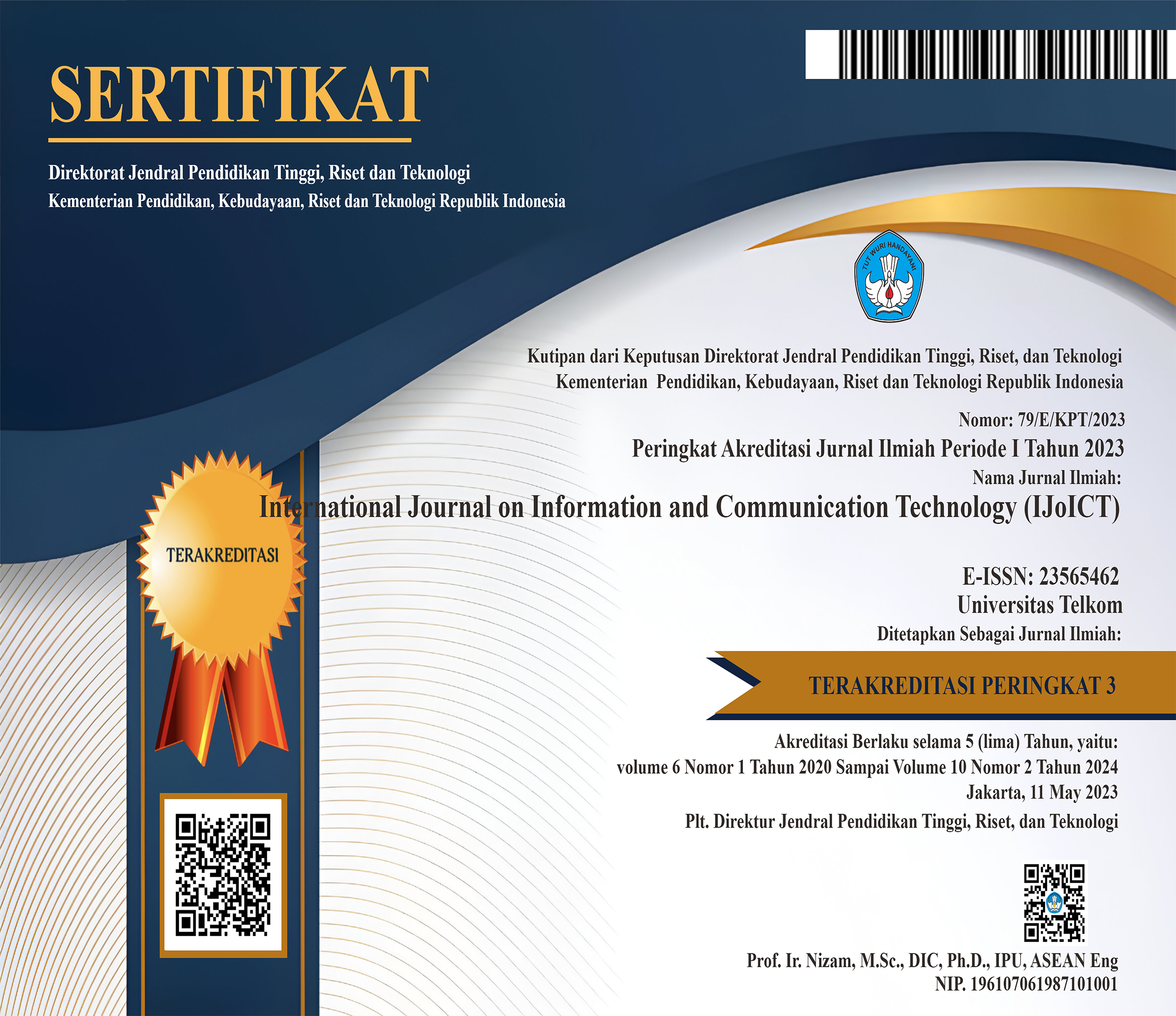Convolutional Neural Network Implementation with AlexNet Architecture for Face Recognition
 Abstract views: 101
,
Abstract views: 101
,
 pdf downloads: 38
pdf downloads: 38
Abstract
In today's digital era, the process of facial recognition has a very big role. Face recognition has benefits for authentication and identification processes. The development of facial recognition research continues to be carried out with the aim of being able to get the right algorithm, more accurate, faster processing, to be able to recognize faces from various angles. In this study, a performance test was performed on the Convolutional Neural Network (CNN) algorithm with the AlexNet architecture, which is one of the deep learning algorithm developments for facial recognition. AlexNet has 8 convolution layers so that it will not leave even the slightest feature of the object. The process of training and testing the system uses the MATLAB programming language. The number of datasets used is 400 image data which is divided into 360 training image data and 40 test image data. The 400 data come from 4 classes of facial images that have been labeled with names and each classes have 100 images. The training process produces an accuracy of 100% and the testing process produces an accuracy of 95%.
Downloads
References
[2] P. Viola and M. Jones, “Rapid object detection using a boosted cascade of simple features,” in Proceedings of the IEEE Computer Society Conference on Computer Vision and Pattern Recognition, 2001, vol. 1, doi: 10.1109/cvpr.2001.990517.
[3] D. Hardiyanto and D. Anggun Sartika, “Optimalisasi Metode Deteksi Wajah berbasis Pengolahan Citra untuk Aplikasi Identifikasi Wajah pada Presensi Digital,” Setrum Sist. Kendali-Tenaga-Elektronika-Telekomunikasi-Komputer, vol. 7, no. 1, pp. 107–116, 2018, doi: 10.36055/setrum.v7i1.3367.
[4] R. Wiryadinata, U. Istiyah, R. Fahrizal, P. Priswanto, and S. Wardoyo, “Sistem Presensi Menggunakan Algoritme Eigenface dengan Deteksi Aksesoris dan Ekspresi Wajah,” J. Nas. Tek. Elektro dan Teknol. Inf., vol. 6, no. 2, pp. 222–229, 2017, doi: 10.22146/jnteti.v6i2.319.
[5] R. Wiryadinata, R. Sagita, S. Wardoyo, and P. Priswanto, “Pengenalan Wajah pada Sistem Presensi Menggunakan Metode Dynamic Times Wrapping, Principal Component Analysis dan Gabor Wavelet,” J. Din. Rekayasa, vol. 12, no. 1, pp. 1–8, 2016, [Online]. Available: http://dinarek.unsoed.ac.id/jurnal/index.php/dinarek/article/view/138.
[6] S. Wardoyo, R. Wiryadinata, and R. Sagita, “Sistem Presensi Berbasis Agoritma Eigenface Dengan Metode Principal Component Analysis,” J. Setrum, vol. 3, no. 1, pp. 61–68, 2014, [Online]. Available: https://jurnal.untirta.ac.id/index.php/jis/article/viewFile/498/386.
[7] O. Russakovsky et al., “ImageNet Large Scale Visual Recognition Challenge,” Int. J. Comput. Vis., vol. 115, no. 3, pp. 211–252, 2015, doi: https://doi.org/10.1007/s11263-015-0816-y.
[8] M. Jiang, X. Fan, and H. Yan, “RetinaMask: A Face Mask detector,” Arxiv, 2020.
[9] F. Sirait and Y. Yoserizal, “Pemanfaatan Raspberry Pi Sebagai Processor Pada Pendeteksian Dan Pengenalan Pola Wajah,” J. Teknol. Elektro, vol. 7, no. 3, pp. 146–150, 2016, doi: 10.22441/jte.v7i3.892.
[10] M. M. Lambacing and F. Ferdiansyah, “Rancang Bangun New Normal Covid-19 Masker Detektor Dengan Notifikasi Telegram Berbasis Internet of Things,” Dinamik, vol. 25, no. 2, pp. 77–84, 2020, doi: 10.35315/dinamik.v25i2.8070.
[11] Efanntyo and A. Rama Mitra, “Perancangan Aplikasi Sistem Pengenalan Wajah Dengan Metode Convolutional Neural Network ( CNN ) Untuk Pencatatan Kehadiran Karyawan,” J. Instrumentasi dan Teknol. Inform., vol. 3, no. 1, pp. 1–11, 2021.
[12] T. E. of Encyclopaedia, “Bill Gates American computer programmer, businessman, and philanthropist,” Encyclopedia Britannica, 2023. https://www.britannica.com/biography/Bill-Gates.
[13] A. Pujara, “Concept of AlexNet: Convolutional Neural Network,” Analytics Vidhya, 2023. https://medium.com/analytics-vidhya/concept-of-alexnet-convolutional-neural-network-6e73b4f9ee30.
[14] Wikipedia, “Alexnet,” Wikipedia the free encyclopedia, 2023. https://en.wikipedia.org/wiki/AlexNet.
[15] S. Narkhede, “Understanding Confusion Matrix,” Towards Data Science, 2018. https://towardsdatascience.com/understanding-confusion-matrix-a9ad42dcfd62 (accessed Jul. 25, 2023).
[16] I. Kandel and M. Castelli, “The effect of batch size on the generalizability of the convolutional neural networks on a histopathology dataset,” ICT Express, vol. 6, no. 4, pp. 312–315, 2020, doi: https://doi.org/10.1016/j.icte.2020.04.010.

This work is licensed under a Creative Commons Attribution 4.0 International License.
Manuscript submitted to IJoICT has to be an original work of the author(s), contains no element of plagiarism, and has never been published or is not being considered for publication in other journals. Author(s) shall agree to assign all copyright of published article to IJoICT. Requests related to future re-use and re-publication of major or substantial parts of the article must be consulted with the editors of IJoICT.









.png)

.jpg)




